Editorial
Well I've been back at work for over two weeks now and so far, no great problems. This is good (a) for the cashflow, and (b) because new things that I study as part of my research have a way of finding their way into the Model Engine News web site. This month, it's Google Maps and Street-View. About the only page I could think of that would benefit from the technology is the sadly neglected page for the control line club to which I belong, the Thunderbirds whose main page now has a How to get there link. If you zoom right in on the T'birds field, the mark-out of one of the circles for mouse racing is clearly visible. Too bad nobody was flying when the bird last went over, and yes, we do get some turbulence from wind blowing over the tree tops.
There has been a little activity in the shop and I expect it to increase as my strength returns and the weather warms up a bit more. In the past month, I've been helping a friend replace the front bearing in a Super Tigre .46 G-21. This should have been simple, but nothing we've tried can get the wrist pin out through the bung hole in the back of the crankcase. It must be well and truly glued into the piston. We've tried heat, metho, the normally reliable ATF/acetone mix, and a taper tap in the inner hole to get a good grip, but nothing will shift it. This is bad because until the pin comes out, we can't remove the shaft to replace the bearing. Neither can we reassemble the engine because there's no way to compress the ring back into the liner as it's totally inaccessible. At the moment, it looks like I'll have to saw the rod in half and make a new one. At least the saga will make a good tech tip at some future time.
Chenery/Stone Gnome
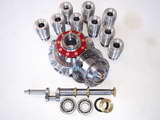
In our little Motor Boy group, the most prolific builder would be Les Stone. Take a look at his Tribute Page to get a feel for the breadth and depth of Les' work. Although he has a Hodgson Radial under his belt, Les has decided to go to the next round engine level, a Gnome rotary. The design is the well known and proven one by the late Les Chenery. The prototype won Les Chenery the Duke of Edinborough Challange Cup (when?). Les Stone bought his plans set and ring casting when they were advertised in the second issue of SIC. Both were left under the bench to mature until March this year. The photo shows Les' remarkable progress in just five months. There is still a lot to do, but Les has certainly made progress and we look forward to watching this project come together.
Progress at Adelaide Aeromotive
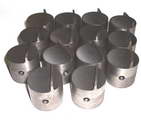
In the June 2010 issue, we mentioned that Adelaide Aeromotive (AA) was intending to (re) produce new old Taipans and Glow Chief engines. This is no small task, but David Burke is making progress and keeping those who have registered appraised of what's going on. The photo here from his August update shows a flock of part finished Glow Chief 29/35 pistons forming part of the AA Repair Service. They have been finished to a stage that allows them to drop into fixtures for final homing to a customers' liner, providing a faster turnaround and reduced price as they are manufactured in quantity. Good thinking, 99.
Humbug Fever
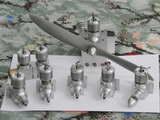
The first plans-built Humbug was completed by Michael Atkinson, Cornwall, UK (see the May 2010 Issue. Well Mike appears to have caught some sort of bug from the experience which causes the production of even more Humbugs! They are not all made slavishly to the drawings and articles currently being serialized in Model Engine Builder; Mike is experimenting with changes and ideas of his own which is exactly what I hoped builders would do. I have no problem with this, even though others have expressed reservations about builder thinking for themselves (see EZE 1). I believe anyone with the ability to complete a model engine will understand the potential dangers of deviating from an established design and have the character to accept responsibility if things don't work out, as well as the praise when they do. That's the way we learn things.
Atom Minor Glow
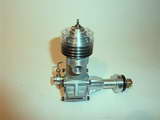
Here's a case to support my point in the previous item. At first glance, this is a Westbury Atom Minor Mk 111, but closer inspection shows some differences, front, back, and top. The engine is the work of Rob Jenkins, Sydney, Australia. Rob had tried to run his example on glow ignition with no success, so he emailed asking for suggestions. Knowing that the Atom was designed for sparks and petrol, I replied that the compression ratio was too low for methanol, and that I seemed to remember an article in the Model Engineer detailing a glow head conversion. In no time at all, Rob has identified the issue in question (Volume 130, Issue 3244, page 179, titled "New Ignition" by RG Weavind) and decided now that he knew what the problem was, he could fashion a better looking solution. Rob's Atom Minor is now turning a 10x6 at 9,200 rpm on glow ignition, and still freeing-up (see Ted Martin on how long this might take). The engine is destined for a control line model where is will really look the biscuit for Ye Olde Tyme stunter. Rob is willing to share his Glow Head details. Let us know if you are interested.
Ozzies Win F2C WC, Again
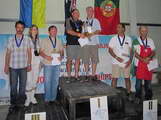
Now pardon me if I go a little parochial. Last year, the Australian team of Hugh Simons and Grant Potter won the F2C (team race) at the World Control-line Championships, held in France. This year the World Champs were held in Hungary and again, an Australian team won top spot on the F2C podium, but this time it is the team of Robert Fitzgerald and Mark Ellins. To win at this level of competition requires an outstanding understanding of engine performance and operation, not to mention piloting, zero-mistake team work, and other things. We congratulate Robert and Mark for their terrific effort in a field of twenty-five highly competitive and aggressive—in a friendly way—teams.
The Lost Leesil
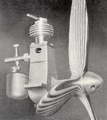
If you've heard of the Leesil at all, I'll wager this is the picture that pops into mind when the name pops up. It appears in Dickie Dickson's 1947 book "Model Diesels", and has appeared in Aeromodeller at least twice that I can think of. However, there were other Leesils! There was one before the Dyno clone shown in this picture, and as I now know, there was also a RRV Leesil! A reader has sent in photos of his example of this rare engine, so I've put together a quickie-page on the Leesil RRV diesel that will at least answer the question of which came first, the side-port, or the RRV.
New Books and Magazines This Month

The only new items squeezed into The Library this month were issues of The Model Engineer, and issue 167 of sister publication, Model Engineers' Workshop (MEW). Somehow I don't find MEW quite as useful as I once did due to dilution by non-workshop related articles, but it's still a damn good magazine and every issue has a good idea or two that make it worth the subscription. To me, one of the stand-out pieces in #167 was A Beginner's Journey, by David Reece. The editor may have thought so as well because two of the cover photos come from that article, the el-neat-o emery cloth holder in the middle at the bottom, and the main photo itself showing the use of a "strap wrench" to gently remove lathe chucks of the screw-on variety. By coincidence, a flyer from RS components arrived on my desk a few days after I saw #167, offering 60% off just such a tool. How could I resist, and for more on this, see this month's Tech-Tip.
Now, click on the thumbnail pic of MEW #167 and examine the main photo closely, then ask yourself, what is wrong with this picture?! Just in case you've had a hard day and can't be bothered with puzzles, hover here for the answer.
Engine Of The Month: Boxer
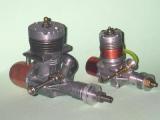
Boxer? From Japan? Never heard of it. But Adrian Duncan has managed to locate two very different examples which he puts under the macro-scope for us this month. The engine appeared rather briefly in the period shortly following World War II. Japan's economy and industry at this time was a mess and although Japan did not officially fall under the Marshall Plan which was helping Europe to rebuild, the US did pour money and other assistance into the country, which was quick to respond and rebuild. What many fail to realize is that there was a thriving domestic model engine market in Japan before the war, so the fact that small model engine companies tried with varying success to carry on again after should be no surprise. The Boxer didn't last long, but is certainly worth remembering.
Tech Tip of the Month
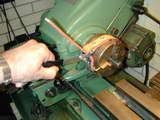
This month's Tech Tip was inspired by the cover photo of MEW #167 and discusses some ways of removing screw-on lathe chucks. But before we start, it would be a good idea to review the Tech Tip from February 2004 which relates how a chuck can become well and truely stuck. Another stuck-chuck tale of woe appeared in one of Guy Lautard's Machinist's Bedside Reader series. In this story, the chuck was stuck so tightly that the only cure was to turn away the chuck backplate and screws to remove the chuck, then carefully machine away the remains of the backplate from the spindle nose. A new backplate was then turned up and fitted in a late night blitz so the machine would be back in use before the boss arrived the next morning! That's as extreme as we want to get, so follow this link to the Stuck Chuck page.
 Chenery/Stone Gnome
Chenery/Stone Gnome
 Progress at Adelaide Aeromotive
Progress at Adelaide Aeromotive
 Humbug Fever
Humbug Fever
 Atom Minor Glow
Atom Minor Glow
 Ozzies Win F2C WC, Again
Ozzies Win F2C WC, Again
 The Lost Leesil
The Lost Leesil
 Editorial
Editorial
 New Books and Magazines This Month
New Books and Magazines This Month
 Engine Of The Month: Boxer
Engine Of The Month: Boxer
 Tech Tip of the Month
Tech Tip of the Month
 Standard Stuff
Standard Stuff









